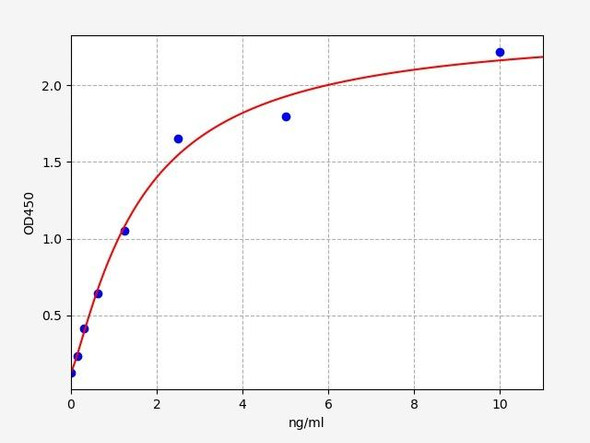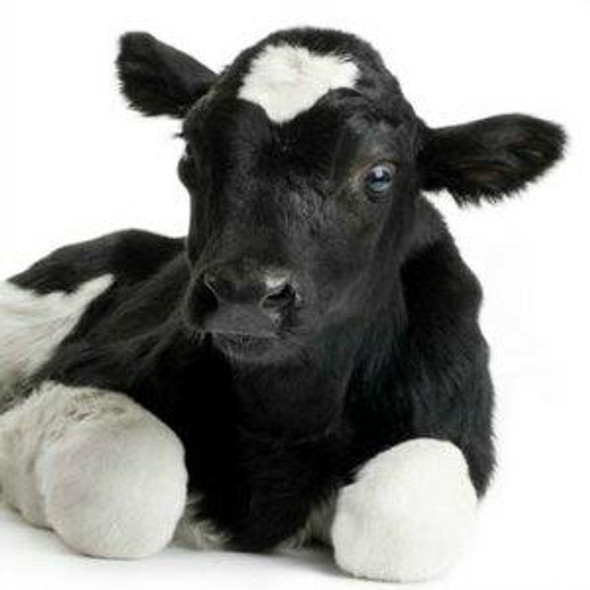Mouse TLR9 (Toll-like Receptor 9) ELISA Kit (MOES01571)
- SKU:
- MOES01571
- Product Type:
- ELISA Kit
- Size:
- 96 Assays
- Uniprot:
- Q9EQU3
- Sensitivity:
- 0.09ng/mL
- Range:
- 0.16-10ng/mL
- ELISA Type:
- Sandwich
- Synonyms:
- CD289
- Reactivity:
- Mouse
- Sample Type:
- Serum, plasma and other biological fluids
- Research Area:
- Immunology
Description
Mouse TLR9 (Toll-like Receptor 9) ELISA Kit
The Mouse TLR9 (Toll-Like Receptor 9) ELISA Kit is a highly accurate and efficient tool for the quantification of TLR9 levels in mouse serum, plasma, and cell culture supernatants. This kit is known for its exceptional sensitivity and specificity, ensuring the generation of precise and reproducible data for a variety of research purposes.TLR9 is a critical component of the immune system, responsible for recognizing and responding to microbial DNA, thereby triggering an immune response.
Dysregulation of TLR9 has been associated with various diseases, including autoimmune disorders and infectious diseases, making it a valuable target for studying immune responses and developing potential therapies.The Mouse TLR9 ELISA Kit from Assay Genie offers researchers a reliable and efficient method for the quantitative analysis of TLR9 levels in mouse samples, providing valuable insights into immune responses and inflammatory processes.
| Assay type: | Sandwich |
| Format: | 96T |
| Assay time: | 4.5h |
| Reactivity: | Mouse |
| Detection Method: | Colormetric |
| Detection Range: | 0.16-10 ng/mL |
| Sensitivity: | 0.10 ng/mL |
| Sample Volume Required Per Well: | 100µL |
| Sample Type: | Serum, plasma and other biological fluids |
| Specificity: | This kit recognizes Mouse TLR9 in samples. No significant cross-reactivity or interference between Mouse TLR9 and analogues was observed. |
This ELISA kit uses Sandwich-ELISA as the method. The micro ELISA plate provided in this kit has been pre-coated with an antibody specific to Mouse TLR9. Standards or samples are added to the appropriate micro ELISA plate wells and combined with the specific antibody. Then a biotinylated detection antibody specific for Mouse TLR9 and Avidin-Horseradish Peroxidase (HRP) conjugate are added to each micro plate well successively and incubated. Free components are washed away. The substrate solution is added to each well. Only those wells that contain Mouse TLR9, biotinylated detection antibody and Avidin-HRP conjugate will appear blue in color. The enzyme-substrate reaction is terminated by adding Stop Solution and the color turns yellow. The optical density (OD) is measured spectrophotometrically at a wavelength of 450 nm ± 2 nm. The OD value is proportional to the concentration of Mouse TLR9. The concentration of Mouse TLR9 in samples can be calculated by comparing the OD of the samples to the standard curve.
| UniProt Protein Function: | TLR9: Key component of innate and adaptive immunity. TLRs (Toll-like receptors) control host immune response against pathogens through recognition of molecular patterns specific to microorganisms. TLR9 is a nucleotide-sensing TLR which is activated by unmethylated cytidine-phosphate-guanosine (CpG) dinucleotides. Acts via MYD88 and TRAF6, leading to NF-kappa-B activation, cytokine secretion and the inflammatory response. Controls lymphocyte response to Helicobacter infection. Interacts with MYD88 via their respective TIR domains. Interacts (via transmembrane domain) with UNC93B1. Interacts with CD300LH; the interaction may promote full activation of TLR9-triggered innate responses. Interacts with BTK. Interacts with CNPY3 and HSP90B1; this interaction is required for proper folding in the endoplasmic reticulum. Highly expressed in spleen, lymph node, tonsil and peripheral blood leukocytes, especially in plasmacytoid pre- dendritic cells. Levels are much lower in monocytes and CD11c+ immature dendritic cells. Also detected in lung and liver. Belongs to the Toll-like receptor family. 5 isoforms of the human protein are produced by alternative splicing. |
| UniProt Protein Details: | Protein type:Membrane protein, integral; Receptor, misc. Chromosomal Location of Human Ortholog: 9|9 F1 Cellular Component: apical plasma membrane; basolateral plasma membrane; cytoplasm; endoplasmic reticulum; endosome; lysosome; plasma membrane Molecular Function:interleukin-1 receptor binding; protein binding; siRNA binding; unmethylated CpG binding Biological Process: activation of NF-kappaB transcription factor; defense response to Gram-negative bacterium; defense response to virus; I-kappaB phosphorylation; immune response; inhibition of NF-kappaB transcription factor; innate immune response; maintenance of gastrointestinal epithelium; microglial cell activation; negative regulation of interleukin-6 production; negative regulation of interleukin-8 production; negative regulation of toll-like receptor signaling pathway; positive regulation of autophagy; positive regulation of chemokine production; positive regulation of granulocyte macrophage colony-stimulating factor production; positive regulation of I-kappaB kinase/NF-kappaB cascade; positive regulation of interferon-alpha biosynthetic process; positive regulation of interferon-beta biosynthetic process; positive regulation of interferon-beta production; positive regulation of interferon-gamma biosynthetic process; positive regulation of interleukin-10 production; positive regulation of interleukin-12 production; positive regulation of interleukin-18 production; positive regulation of interleukin-6 production; positive regulation of interleukin-8 production; positive regulation of JNK activity; positive regulation of NF-kappaB import into nucleus; positive regulation of nitric-oxide synthase biosynthetic process; positive regulation of toll-like receptor signaling pathway; positive regulation of transcription from RNA polymerase II promoter; positive regulation of tumor necrosis factor production; regulation of B cell activation; regulation of dendritic cell cytokine production; regulation of inflammatory response; regulation of protein amino acid phosphorylation; response to molecule of bacterial origin; response to virus; toll-like receptor signaling pathway; tumor necrosis factor production |
| UniProt Code: | Q9EQU3 |
| NCBI GenInfo Identifier: | 363548499 |
| NCBI Gene ID: | 81897 |
| NCBI Accession: | Q9EQU3. 3 |
| UniProt Secondary Accession: | Q9EQU3,Q4L0K3, Q4L0K4, Q99MF2, Q99MQ8, F8VPN5, |
| UniProt Related Accession: | Q9EQU3 |
| Molecular Weight: | 116,412 Da |
| NCBI Full Name: | Toll-like receptor 9 |
| NCBI Synonym Full Names: | toll-like receptor 9 |
| NCBI Official Symbol: | Tlr9 |
| NCBI Protein Information: | toll-like receptor 9 |
| UniProt Protein Name: | Toll-like receptor 9 |
| UniProt Synonym Protein Names: | CD_antigen: CD289 |
| Protein Family: | Toll-like receptor |
| UniProt Gene Name: | Tlr9 |
As the OD values of the standard curve may vary according to the conditions of the actual assay performance (e. g. operator, pipetting technique, washing technique or temperature effects), the operator should establish a standard curve for each test. Typical standard curve and data is provided below for reference only.
| Concentration (ng/mL) | O.D | Average | Corrected |
| 10 | 2.335 2.371 | 2.353 | 2.284 |
| 5 | 1.5 1.548 | 1.524 | 1.455 |
| 2.5 | 0.857 0.825 | 0.841 | 0.772 |
| 1.25 | 0.439 0.471 | 0.455 | 0.386 |
| 0.63 | 0.243 0.221 | 0.232 | 0.163 |
| 0.32 | 0.174 0.152 | 0.163 | 0.094 |
| 0.16 | 0.116 0.12 | 0.118 | 0.049 |
| 0 | 0.06 0.078 | 0.069 | -- |
Precision
Intra-assay Precision (Precision within an assay): 3 samples with low, mid range and high level Mouse TLR9 were tested 20 times on one plate, respectively.
Inter-assay Precision (Precision between assays): 3 samples with low, mid range and high level Mouse TLR9 were tested on 3 different plates, 20 replicates in each plate.
| Intra-assay Precision | Inter-assay Precision | |||||
| Sample | 1 | 2 | 3 | 1 | 2 | 3 |
| n | 20 | 20 | 20 | 20 | 20 | 20 |
| Mean (ng/mL) | 0.52 | 1.20 | 4.57 | 0.48 | 1.19 | 4.30 |
| Standard deviation | 0.03 | 0.07 | 0.15 | 0.03 | 0.06 | 0.21 |
| C V (%) | 5.77 | 5.83 | 3.28 | 6.25 | 5.04 | 4.88 |
Recovery
The recovery of Mouse TLR9 spiked at three different levels in samples throughout the range of the assay was evaluated in various matrices.
| Sample Type | Range (%) | Average Recovery (%) |
| Serum (n=5) | 93-110 | 100 |
| EDTA plasma (n=5) | 92-110 | 100 |
| Cell culture media (n=5) | 93-105 | 98 |
Linearity
Samples were spiked with high concentrations of Mouse TLR9 and diluted with Reference Standard & Sample Diluent to produce samples with values within the range of the assay.
| Serum (n=5) | EDTA plasma (n=5) | Cell culture media (n=5) | ||
| 1:2 | Range (%) | 94-107 | 92-107 | 95-107 |
| Average (%) | 101 | 100 | 101 | |
| 1:4 | Range (%) | 90-106 | 81-96 | 87-101 |
| Average (%) | 97 | 88 | 92 | |
| 1:8 | Range (%) | 89-100 | 86-98 | 87-101 |
| Average (%) | 94 | 91 | 92 | |
| 1:16 | Range (%) | 86-100 | 86-98 | 86-98 |
| Average (%) | 93 | 92 | 91 |
An unopened kit can be stored at 4°C for 1 month. If the kit is not used within 1 month, store the items separately according to the following conditions once the kit is received.
| Item | Specifications | Storage |
| Micro ELISA Plate(Dismountable) | 8 wells ×12 strips | -20°C, 6 months |
| Reference Standard | 2 vials | |
| Concentrated Biotinylated Detection Ab (100×) | 1 vial, 120 µL | |
| Concentrated HRP Conjugate (100×) | 1 vial, 120 µL | -20°C(shading light), 6 months |
| Reference Standard & Sample Diluent | 1 vial, 20 mL | 4°C, 6 months |
| Biotinylated Detection Ab Diluent | 1 vial, 14 mL | |
| HRP Conjugate Diluent | 1 vial, 14 mL | |
| Concentrated Wash Buffer (25×) | 1 vial, 30 mL | |
| Substrate Reagent | 1 vial, 10 mL | 4°C(shading light) |
| Stop Solution | 1 vial, 10 mL | 4°C |
| Plate Sealer | 5 pieces | |
| Product Description | 1 copy | |
| Certificate of Analysis | 1 copy |
- Set standard, test sample and control (zero) wells on the pre-coated plate and record theirpositions. It is recommended to measure each standard and sample in duplicate. Note: addall solutions to the bottom of the plate wells while avoiding contact with the well walls. Ensuresolutions do not foam when adding to the wells.
- Aliquot 100µl of standard solutions into the standard wells.
- Add 100µl of Sample / Standard dilution buffer into the control (zero) well.
- Add 100µl of properly diluted sample (serum, plasma, tissue homogenates and otherbiological fluids) into test sample wells.
- Cover the plate with the sealer provided in the kit and incubate for 90 min at 37°C.
- Aspirate the liquid from each well, do not wash. Immediately add 100µL of BiotinylatedDetection Ab working solution to each well. Cover the plate with a plate seal and gently mix. Incubate for 1 hour at 37°C.
- Aspirate or decant the solution from the plate and add 350µL of wash buffer to each welland incubate for 1-2 minutes at room temperature. Aspirate the solution from each well andclap the plate on absorbent filter paper to dry. Repeat this process 3 times. Note: a microplatewasher can be used in this step and other wash steps.
- Add 100µL of HRP Conjugate working solution to each well. Cover with a plate seal andincubate for 30 min at 37°C.
- Aspirate or decant the solution from each well. Repeat the wash process for five times asconducted in step 7.
- Add 90µL of Substrate Reagent to each well. Cover with a new plate seal and incubate forapproximately 15 min at 37°C. Protect the plate from light. Note: the reaction time can beshortened or extended according to the actual color change, but not by more than 30min.
- Add 50 µL of Stop Solution to each well. Note: Adding the stop solution should be done inthe same order as the substrate solution.
- Determine the optical density (OD value) of each well immediately with a microplate readerset at 450 nm.









